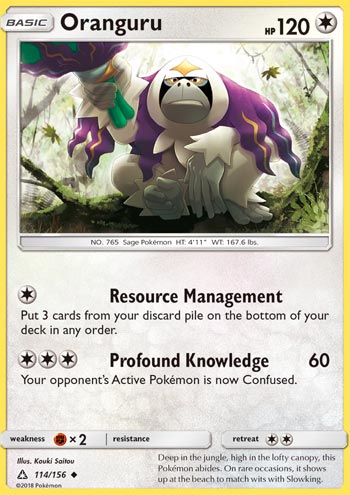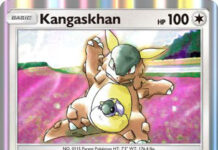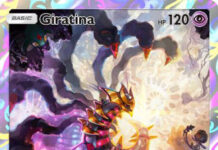
#7 – Oranguru
– Ultra Prism
Date Reviewed:
December 21, 2018
Ratings Summary:
Standard: 3.76
Expanded: 3.63
Limited: 3.50
Ratings are based on a 1 to 5 scale. 1 is horrible. 3 is average. 5 is great.
Reviews Below:
 Vince Our 7th place pick is Oranguru from Sun & Moon Ultra Prism. I did not consider this card to be on the list, but it seems to be getting more recognition now. It’s mostly a support Pokémon seen of control variants. The attack, Resource Management, is the reason why Oranguru sees play, as it puts three cards from your discard pile onto the bottom of your deck – for the cost of a single energy. And the Looker Supporter card draws the bottom three cards from your deck, which would be exactly what you need. Sure, your opponent may try to disrupt your deck with Judge or other deck shuffling cards, but if left unattended, it can create a somewhat unstoppable cycle of disruption provided you choose the right cards. Makes Zoroark-GX’s Trade ability not so much of a liability as the cards that you’ve discarded can be brought back. And it keeps you from decking out. Ratings: Standard: 4/5 (You won’t see this Pokémon too often, but when it does, it shows its true colors) Expanded: 3.75/5 (You’ll get disrupted pretty often here with N.) Limited: 3/5 (A 120 HP basic with a second attack that does 60 damage with Confusion for three energy isn’t too shabby, but there’s not much else to recommend.) Notes: So far, there’s two good Oranguru cards to use for Standard. One is this one, and the other one from Sun & Moon draws cards via ability. Next Up: This Pokemon has been working out, which gave it enough strength to make it on the list. |
 21times Oranguru (UPR 114) swung into the Pokemon TCG out of the Ultra Prism expansion set. Resource Management kind of got past us at first. While we fawned over Dusk Mane Necrozma GX and Glaceon GX, this guy kind of undulated beneath the radar for a while. Several top finishing Zoroark GX lists played this card (even some as soon as it became Standard legal at Collinsville), but it really had its best showing at the North American International Championship in July where Tord Reklev first displayed the devastatingly dominant “Zoroark Controls” archetype which would soon lead to the banning of Puzzle of Time (BKP 109). Many of us wrote this card off because of its Fighting weakness and the fact that you would have to put the three cards at the bottom of your deck. When UPR first came out, I knew Oranguru could be paired with Evoshock Raichu (BUS 41) in what would become known as the “Shock Lock” deck. And that archetype could be EXTREMELY nasty, even if your opponent played four Guzmas. But I hadn’t thought of using Oranguru much beyond that. Most of us failed to realize just how good Oranguru, Puzzle of Time, and Zoroark GX could be. Pretty much the only card that could stop it was Garbotoxin Garbodor… and even then it might come down to whether or not the Controls player could find Field Blower early on. While it definitely lost its most potent Tool in Puzzle of Time, we haven’t seen the last of Oranguru UPR yet. The top finishing deck at Harrogate this weekend played a copy. We have so many new cards coming into the format in February that carry some mystique and ambiguity that someone may yet again find a combination that will bring Resource Management Oranguru back into the forefront of a crazy new controls / stall archetype that will frustrate the meta to no end. Rating Standard: 3.5 out of 5 Conclusion I never played Oranguru UPR much after my experimenting with the Shock Lock deck. You would think, with my love of Sylveon GX and other stall and mill archetypes, that I would have used this card a lot more than I did. I just never really felt particularly comfortable with it though. Maybe it’s just me, maybe I don’t have the vision or creativity involved in using this card, maybe I just didn’t spend enough time with it. It could very well be worth keeping in mind, however, when theorymonning about new cards coming out very soon. |
 Otaku We close out this week with the seventh-place finisher in our Top 11 Countdown of 2018. Why a Top 11? So that we wrap things up with the exact end of the year. Today we’re re-reviewing Oranguru (SM – Ultra Prism 114/156), though in my case this is my first time reviewing it. Why? Digging through my files it appears I just ran out of time to write the review, possibly because I had to delete what was a less-than-flattering review of the card. I don’t know what my first thoughts were when I saw this Oranguru, but back when we were crafting Top 10 lists for SM – Ultra Prism, I thought it was mostly hopeless, that it might fill some niche role in a moderately successful deck. This Oranguru is nowhere near as heavily played as the original Oranguru (Sun & Moon 113/149, SM – Black Star Promos SM13), but calling it niche may be misleading. It does fill a seemingly small, specialized role, but in a couple competitive decks, including at least one winning tournaments in both Standard and Expanded: Zoroark Control. As this is my first official review of Oranguru, let us take a step back and run through what the card is and what it does, then I’ll connect the dots for anyone who still needs the assist. Oranguru is a [C] Type Pokémon; it isn’t played to attack for damage, so the fact that there’s no [C] Weakness or Resistance unless we mess with the Unlimited Format – which we aren’t – isn’t particularly helpful. There are some bits of support and counters for the Type in Expanded, but they haven’t been competitively useful in a while, or never were in the first place. As a Basic, Oranguru can be your opening Active (not always a good thing), requires minimal space and effort to field, can access a few bits of support but has to deal with a few counters as well… though less than many other Basics, because of how Oranguru is used. It’s 120 HP is just a bit below what we’d like; most attackers – including Zoroark-GX – are looking at a OHKO if they have a good setup. [F] Weakness means Fighting Types are even more likely to manage it, especially in Expanded where they still have Muscle Band, Regirock-EX and Strong Energy to supplement Diancie {*} and – in the case of Buzzwole and Buzzwole-GX – Beast Energy {*}. Resistance would help a little but it’s totally absent, so moving on we have a Retreat Cost of [CC] that is mediocre; you can probably pay it if you must but it can be a real pain when resources are scarce. Oranguru has two attacks; the first is “Resource Management” for [C], allowing you to bottom deck three cards from your discard pile, while the second is “Profound Knowledge” for [CCC], which does 60 damage and leaves the opponent’s Active Confused. The second attack is mostly window dressing; you technically can use it, but most of the time it just won’t be worth it because you’re not doing enough damage for the Energy. Maybe some of the newer cards, revealed or released in Japan, that augment Confusion will change this but… that’ll be then and this is now. It is Resource Management that lives up to its name. Some of us are still jonesing for Puzzle of Time, so we can reclaim anything; I know I’m still missing Special Charge and even the long-since-rotated VS Seeker when it comes to Standard Format play. Sending the cards to the bottom of the deck before combos isn’t ideal; without a searching or shuffling effect, you won’t have a shot at those cards until you’ve nearly decked out. General usage cards like Nest Ball or Ultra Ball can claim a Pokémon (recycled or not) while shuffling your deck around; a simple “combo” for most decks. Any shuffle-and-draw like Cynthia simultaneously randomizes your deck before drawing, giving you the chance of getting what you recycled the turn before. Chances are if Resource Management was used on something important to your deck’s strategy, you’ll have semi-specialized cards like Energy Loto to help fetch Double Colorless Energy or some Energy card. We can take it one step further, however; Looker’s Whistle is an Item which adds up to two copies of Looker from your deck to your hand, and Looker himself is a Supporter that draws the bottom three cards from your deck. If your opponent doesn’t mess up your hand or deck, this combo lets you constantly recycle three cards from the bottom of your deck. Be careful with the timing, though; Looker’s Whistle is used to get that initial Looker into your hand, not turn after turn since it would shuffle your deck while getting Looker, thus keeping Looker from drawing those exact three recycled cards. In the Standard Format, we’ve got Zoroark Control as well as other control-focused decks, such as your typical stall/mill. Can’t confirm the latter for Expanded, but Zoroark Control won the Masters Division of last weekend’s Regional Championship in Anaheim, California. The turn out in this age bracket was 508 players, and last I checked, this is a pretty competitive area even at the local level! The same weekend, in the Masters Division of the Harrogate, Great Britain Regional Championship, a copy of this Oranguru again showed up in the first place deck. This time there were 20 fewer players, but 488 is still a robust turnout. Plus, the deck was Zoroark-GX/Gyarados (SM – Burning Shadows 33/147). I didn’t even know that was a thing! What I have noticed is Oranguru can be helpful for countering Oranguru, at least against the control variants. Girafarig (SM – Lost Thunder 94/214) is probably better, at least against the more precise builds that will have just singles or doubles of many key cards. Each take about the same amount of effort, and each have additional fringe benefits; Giarafarig disrupting some of the other competitive decks, while Oranguru’s recycling can still be useful in general. I just know I’ve taken to running ONE Oranguru (SM – Ultra Prism 114/156) alongside three Oranguru (Sun & Moon 113/149, SM – Black Star Promos SM13) when playing my Granbull (SM – Lost Thunder 138/214) deck. Yes, sometimes today’s version shows up when I don’t need it and gets in the way, but there’s something fun about constantly recycling what someone else is constantly discarding or milling. This Oranguru is great for the Limited Format as well; its HP and second attack are actually viable here, and while it may be harder to access whatever you’re recycling, a second shot at using your best stuff on top of a solid, big Basic attacker is very good… plus Looker and Looker’s Whistle are even in this set! Ratings
I’m glad I got a second chance to give this Oranguru its due, as did the rest of us. It is a very good card, even if it is also a very specialized card. Don’t mistake the above scores for it being potent in anything and everything; in most decks, it would be a functional but sub-optimal play. For a while, the powers-that-be had better remember the recycling engine they’ve given us even in the Standard Format! It isn’t as crazy as something like Sableye (BW – Dark Explorers 62/108) with Puzzle of Time, but half of that combo is banned and the other half is Expanded-only! |
Click here to read our Pokémon Card of the Day Archive. We have reviewed more than 3500 Pokemon cards over the last 17+ years!
We would love more volunteers to help us with our Card of the Day reviews. If you want to share your ideas on cards with other fans, feel free to drop us an email. We’d be happy to link back to your blog / YouTube Channel / etc. 😉



